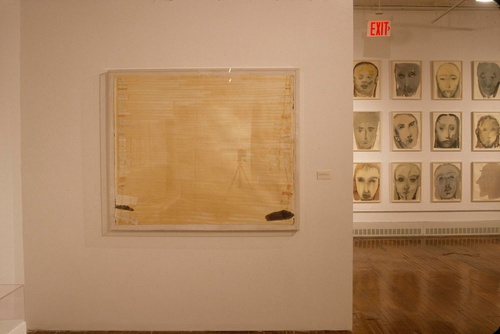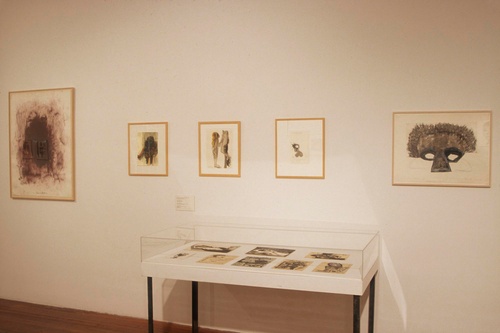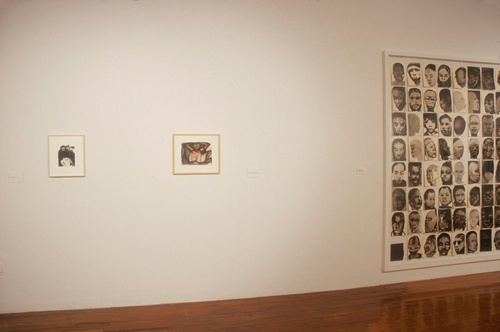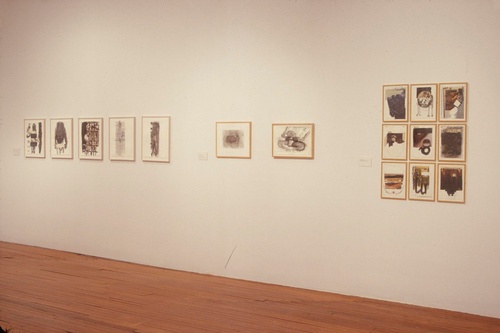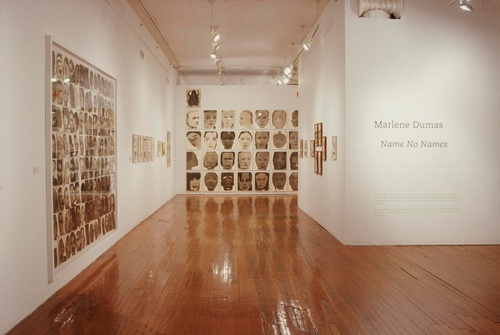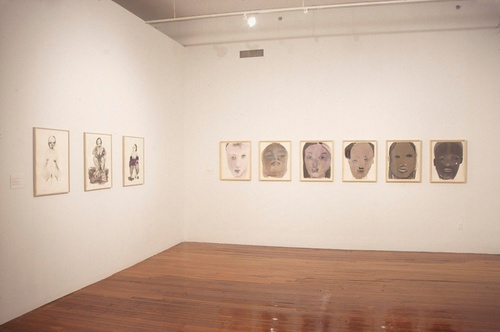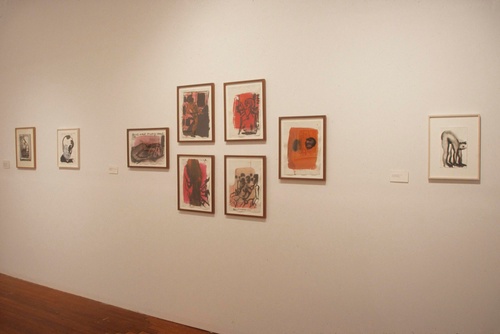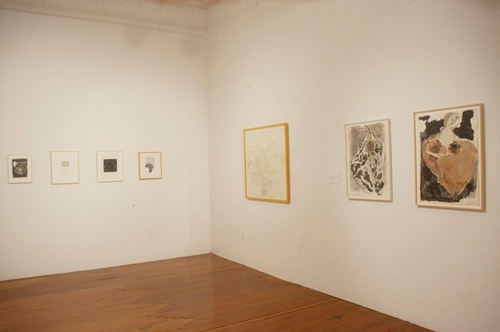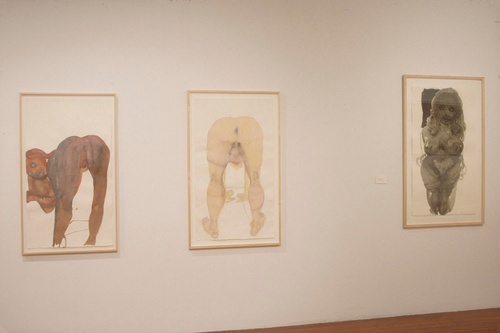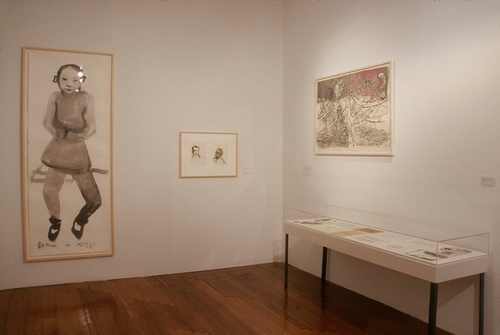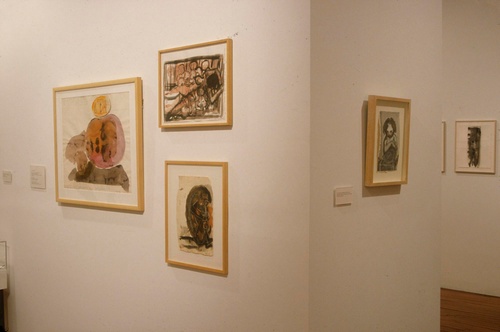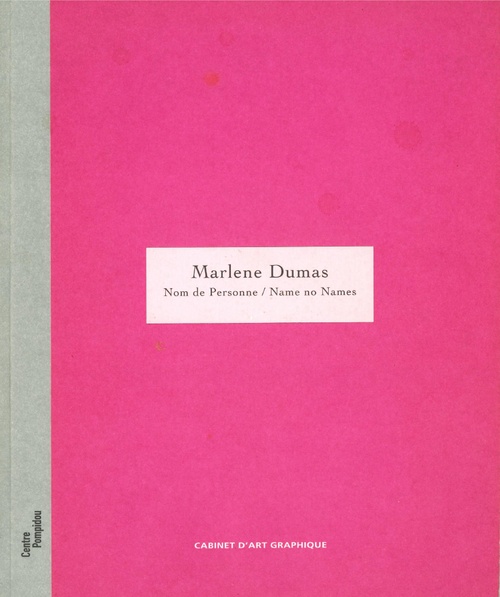Marlene Dumas: Name No Names
Marlene Dumas: Name No Names
An unappreciative critic of Marlene Dumas’s work once bluntly described it as “cheap thrills.” Dumas promptly dubbed the slam a compliment. It was Roland Barthes who, in his famous 1957 essay “Striptease,” alerted us to the complexity of the cheap thrill by way of investigating the ritual of Parisian striptease. The irony of the striptease is that its titillating spell is broken at the moment of actual exposure: a stark naked woman is often somewhat scary and anything but erotic. Marlene Dumas refuses to sustain the striptease; rather, she is always interested in coaxing her subjects into dropping their accoutrements of performative sexuality, gender, and race. Dumas claims that if her work has an aim, it is “to ‘reveal’ not to ‘display.’” This doesn’t mean that her images aren’t sexy: they are. But they are sexy in a raw, dirty kind of way-vaguely pathetic, sometimes embarrassing, often vicious, and always disconcertingly familiar. Insisting that we recognize how inevitably linked intimacy and discomfort are, Dumas makes it her business to root out the well-hidden, but always-present, perversity that is immanent to pleasure-whether we like it or not.
Name No Names, the first comprehensive presentation by a U.S. museum of the acclaimed Amsterdam-based artist’s drawings, offers a rare opportunity to examine the breadth of Marlene Dumas’s works on paper from 1973 to the present. Dumas once said that she wished she could make single-line paintings, as the ancient Chinese did. Her works on paper, though not produced by single gestures, do seem as though they’ve landed all at once and then settled in, easing color and line into unexpected configurations. The images feel like quick bodily utterances: gasps, exclamations, shudders. Yet, it is equally important to notice that these marks, spreading like quick stains, are apt, if clearly distorted, documentations of the world around us. Dumas’s works on paper, like her paintings, might be loosely categorized as a kind of social portraiture. Dumas asks us to re-see her subjects by magnifying them and abstracting them, by disregarding natural proportions and discarding the comforts of context. It’s not just sexual perversion Dumas focuses on as she literally zooms in on her subjects. Her images manifest a perversion or twisting of received social knowledge, a tactical corruption or misinterpretation of meaning.
Born and raised in South Africa, Dumas has said that she “treats all colours as equally strange.” This intentionally ambiguous statement not only invokes the surprising use of pigment in her drawings and paintings, but also directly addresses the ways in which race and gender appear as fluid, undefined entities throughout her works. Over the span of her thirty-year career, Dumas has produced work relating to subjects as diverse and ideologically complicated as apartheid, racial stereotypes, motherhood, polymorphous perversity, love, and religion. The thread that runs through what appears, at first, to be an unwieldy range of topics too large to tackle is the fact that each topic is a social construction. Racial prejudice, for example, relies on sustained social fantasies about hierarchies of physiognomy and skin tone; religion is built around long-standing traditions of fear, hope, and superstition. And for each communally held belief system, there exists a vast repertoire of recognizable images-images that serve to remind and to reference. It is from this archive of cultural sensibility that Dumas culls her images.
Never working from a live model, Dumas always begins with photographs that she gathers from fashion magazines and film archives or photos that she takes herself. Dumas revels in thieving images and quotes from wherever and whomever she wishes-her visual and linguistic vocabularies cobble slightly skewed aphorisms to popular and art historical imagery ranging from Mae West to Josephine Baker to Naomi Campbell to Manet’s Olympia. What makes Dumas’s secondhand depictions so compelling is the way she twists images we’ve come to take for granted so they are structurally undone, made formally strange, as in Josephine (1997), where the timeless star is simply not herself at first glance. Once we are clued in to the figure’s identity through Dumas’s title, the cryptic details of the drawing take on iconic pertinence: though for a moment unrecognizable, this is our Josephine, clutching her veil, barely hiding her nudity, her face lit to the point of racial ambiguity. As one would expect, Dumas’s background as a white South African-born artist is hardly insignificant in any conversation about her work. Drawings like Selfportrait as a Black Girl (1989) and An African Mickey Mouse (1991) directly address the charged political climate in which she grew up. Yet, Dumas makes a point of making her stance on racial politics more about destabilization than didactic persuasion. Her group of six drawings entitled Mixed Blood (1996) is not about any specific race, but rather about the possibility that perhaps there are no specific races to begin with.
For Dumas, no subject is sacred. Her depictions of babies, even her own, are often ambivalent and highlight the monstrous, parasitic nature of human offspring, as in her series Remembrances of Pregnancy (1985- 1989). If Dumas takes on subjects that are considered taboo, it is because taboo itself is based on strict rules of division that the artist simply won’t acknowledge. Like her use of inkwash, which-bleeding, smearing and soaking-extends beyond demarcated lines, her subjects rub up against one another fitfully. In Judas (1994), two faces fill the entire frame of the drawing, their cheeks and lips merging tenderly. The figures’ genders are undefined but similar, sexual but also amoebic, as if they are a single cell, splitting. The image without its title is an all-consuming embrace, one both erotic and disquieting; with its title, the image hurtles us into the biblical story we know so well, but does so with a jolt-who has ever pictured Judas in such a shape-shifting, succubine way before? As Dumas has said, her titles “redirect” the way we see the work. These titles aren’t meant to secure the meaning of the images but, rather, to show how loosely tethered meaning really is to image, and how heavily we rely on what we already know to decipher what’s before us.
Dumas’s words and images refuse singular meaning, yet they frame serious political and ethical questions about apartheid, race, gender, and sexuality. By retaining- even insisting on- ambiguity, Dumas skillfully keeps complicated, open questions just that: questions. Working in what has been called a neo-expressionist, conceptualist style, Dumas has been written about as sharing traits with such diverse artists as Jenny Holzer, Emil Nolde, Barbara Kruger, Edvard Munch, Barbara Bloom, and Francis Bacon. Her recent depictions of strippers and prostitutes are phantoms of Egon Schiele’s muses from the early twentieth century. Dorothy D-lite (1998), bent-over double, vulva displayed, emerges from the thin inkwash as if she were a flickering light. In Under the Volcano (1998), death and sex merge forces; the skin of the stripper has been infused with a fiery glow, and she peers back over her shoulder at the viewer, beckoning ghoulishly with vacant eyes and too-white teeth. Dumas’s strippers, drawn after snapshots she took herself in the red-light district of Amsterdam, are most definitely naked, and most definitely engaged in the trafficking of cheap thrills. Marlene Dumas wouldn’t have it any other way.
-Johanna Burton, Joanne Leonhardt Cassullo Curatorial Fellow
Born in Cape Town, South Africa, Marlene Dumas has lived and worked in the Netherlands since 1976. She has had numerous one-person exhibitions in museums throughout Europe and the U.S., including the Centre Pompidou, National Museum of Modern Art, Paris, the Institute of Contemporary Art, Boston (both 2001) and the Tate Gallery, London (1996), and was a participating artist in the 46th Venice Biennale (1995). Marlene Dumas: Name No Names was conceived of and organized by the Centre Pompidou, National Museum of Modern Art, Paris, and is accompanied by an exhibition catalogue (Centre Pompidou, 2001).
